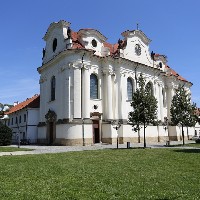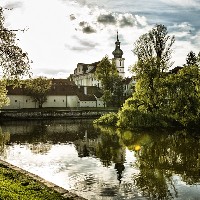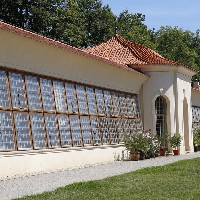Breadcrumbs navigation
Břevnov Monastery, or How to Read Baroque
There are only a few buildings in Prague whose majestic architecture has been preserved in its original, almost intact form. If you find the Baroque as an artistic style difficult to comprehend and are unable to penetrate the secrets of Christian symbolism, the beauty of chiaroscuro paintings, and the aesthetics of dynamic sculptures, try visiting Břevnov Monastery. You’ll find all this under one roof.
The monastery in Břevnov is truly one of the purest examples of Czech High Baroque architecture. Its history, however, dates back many centuries earlier – specifically to 993 AD. At that time, the second bishop of Prague, Vojtěch Slavníkovec, and Prince Boleslav II founded the first, originally a wooden, church with several simple monastic buildings at the source of the Brusnice stream. Roughly carved wooden beams – “břevna” in Czech – from which the original monastery was built, gave rise to the name of the ancient enclosure. Vojtěch then brought a handful of Benedictine monks from Italy to Břevnov who were to become executors of Christian "agitation" in hitherto predominantly pagan Bohemia. However, after the assassination of the Slavníkovec family (from which Vojtěch came) in 995 AD, the monastery more or less disappeared, but was restored in the first half of the 11th century. The derelict wooden buildings were replaced by the Romanesque Basilica of St Margaret with a convent.
From the crypt to the vaults
In the 1960s, archaeologists discovered a unique crypt under the current choir dating back to this period. It is one of the oldest at least partially preserved stone buildings in the country. During the 13th and 14th centuries, most of the buildings here were rebuilt in Gothic style. At that time, the convent was a leading ecclesiastical and cultural institution – it had a large library, through which cults of saints were spread; its members included prominent personalities; and the economic position of the monastery was not insignificant. During the Hussite rampage, the monastery buildings were destroyed, and the subsequent events of the Thirty Years' War completed the work of destruction. It was not until 1708–1745, at a time when the Catholic Church was intensively consolidating its position, that the local order was revived, and a new convent and a magnificent basilica were built, and a partial reconstruction of older parts in the High Baroque style took place. The new monastery complex was designed by Kryštof Dientzenhofer and his son Kilián Ignác. The most beautiful part is without a doubt St Margaret’s church, where all of the significant attributes of the Baroque style are laid out like an architecture textbook: monumentality (to amaze the common man), emotionality, even exaltation, inner tension, pathos, a frescoed vault embodying the image of Heaven transferred to Earth, large canvases with religious themes, sculptures in dynamic poses, and more.
A plethora of Baroque masters
The best artists of their time worked on the interior decoration. The main altar was designed by Kryštof Dientzenhofer and carved by Josef Dobner; the sculptures for the altar as well as the sculptures of Benedictine saints on the sides of the nave were created by Matouš Václav Jäckel. The altarpieces are largely originals by one of the most important Baroque painters, Petr Brandl. The vaults are covered by frescoes by Jan Jakub Steinfels, which are astonishing simply because the artist painted them when he was in his seventies. The inlaid choir benches by Jan Sichmüller are decorated with statues by Richard Prachner; the church organ dates from 1725 and is the work of organist Tobias Meisner. As you can see, it’s just one Baroque delicacy after another.
But it doesn’t end with the church
In addition to St Margaret’s church, the extensive monastery complex includes two-storey convent buildings centered around three courtyards, outbuildings (the renovated granary houses the information center), the prelature (abbot's residence), the Josefka Gloriet, and the Vojtěška Garden Pavilion with a chapel above the well (the source of the Brusnice stream), near which, according to legend the monastery was founded. The icing on this Baroque “cake” is the recently renovated orangery, also the work of Kilián Ignác Dientzenhofer. At the time it was constructed, it served as a greenhouse for growing flowers, fruits, vegetables, and subtropical plants. Today, this impressive building is used as an exhibition space. Directly adjacent to the monastery buildings are a terraced garden, an orchard, and a forest park with a cemetery, where many important Czech personalities have been laid to rest (such as singer Karel Kryl, philosopher Jan Patočka, and Jan Anastáz Opasek, archbishop of the monastery). These large green areas are becoming a frequent destination for Praguers and tourists longing for rest and relaxation.
Blessed golden dew
You may be surprised that “in the house of God” there is time for worldly pleasures – the complex also includes the eco-friendly Hotel Adalbert and the Old Bohemian restaurant Klášterní šenk, featuring beer specialties on tap, such as products from the monastery microbrewery. Some of the monastery’s ceremonial halls are used commercially for various social and cultural events (concerts, weddings, lectures, presentations, banquets, etc.). The monastery’s program includes several popular events throughout the year, including a spring market, a medieval festival, and Christmas Masses and worship services. One of the most popular events is the annual Autumn Fair, which has taken place for over 250 years. The tradition started after Prussian soldiers abandoned the church in 1757, where they had set up a stable and infirmary during the conquest of Prague. The desecrated house of worship then had to be reconsecrated.
The monastery in Břevnov, the oldest men’s monastery in the Czech Republic, with its genius loci, is one of the most important monuments to our oldest history and remains a reminder of the difficult beginnings of Christianity in the Czech lands. Its current Baroque appearance still captivates with its elegance and stylistic purity.
Benedictine Archabbey of St Adalbert and St Margaret
Markétská 1/28, Prague 6 – Břevnov | Monastery gatehouse / information center:
phone: +420 220 406 111, e-mail: klaster@brevnov.cz, www.brevnov.cz
Mon–Fri 8.30 a.m.–5.30 p.m.
Sat–Sun 9 a.m.–4 p.m.
Tours: Sat 10 a.m., 2 p.m., 4 p.m. and Sun 11 a.m., 2 p.m., 4 p.m. (April–October) and Sat 10 a.m., 2 p.m. and Sun 11 a.m., 2 p.m. (November–March); monastery garden open daily from 6.45 a.m. to 8 p.m. On weekdays, tours of the monastery are held only for pre-booked groups between 10 a.m. and 4 p.m.
Other points of interest in the area:
Park Ladronka / prague.eu
A unique combination of park and sports and leisure area. The location got its name from a famous Prague homestead and today it is particularly popular with fans of in-line skating and cycling. Here you’ll find the longest illuminated in-line skating track in Prague (4.2 km). The Ladronka building was renovated into a cultural and social center with a bowling alley and a restaurant. You’ll find a modern children’s playground, as well as beach volleyball and pétanque courts in the immediate vicinity. Every year, the park becomes the venue for one of the largest leisure festivals in our country – Ladronkafest.
Kaštan – Unijazz Club | Popmuseum | Studio | Café / kastan.unijazz.cz
Cultural and community center in Prague 6. The core of the center is a hall with a capacity of about 100 visitors, where concerts, theater performances for children and adults, lectures, film screenings, festivals and exhibitions take place. The building also includes the exhibition Popmuseum, which relates the history of Czechoslovak rock music from 1959–1972. It features a collection of gramophone record covers, artists’ manuscripts, photographs, written documents, audiovisual recordings, period radio receivers, and musical instruments. The Kaštan Studio on the second floor organizes art courses for children, students, adults, seniors, and mothers with children. In the basement you can have a snack in the Únik café.
Hvězda Game Reserve / prague.eu
A large forest park with three long “avenues” that converge in front of a Renaissance summer house shaped like a six-pointed star. Originally used for entertainment and hunting by Prague’s elite in the 16th century, today it is a large recreational zone, where Praguers enjoy relaxing, walking, jogging, cycling, dog walking, and in winter even cross-country skiing. There is an interesting educational trail leading through the park that describes local natural and historical facts and events, including the circumstances of the famous Battle of White Mountain (1620), which took place here. The park has several playgrounds, two picnic places with firepits; in the summer house there is a café with refreshments during the summer season, and occasionally exhibitions and concerts are held here.
How to Get There
Tram 22, 25, 97 – Břevnovský klášter stop
Author: Jan Pomykal, Brand Management Department


